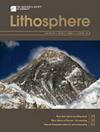壳幔相互作用控制高镁埃达克岩的形成:华北克拉通鲁西地体早白垩世侵入杂岩的证据
IF 1.7
4区 地球科学
Q3 GEOCHEMISTRY & GEOPHYSICS
引用次数: 0
摘要
高镁埃达克岩保存了岩浆演化过程中壳幔相互作用的重要信息。华北克拉通东南部鲁西地体发育一套早白垩世高镁埃达克岩;然而,它们的岩石成因仍然存在争议。本文在由辉长闪长岩、闪长岩、正长岩和二长岩组成的铁寨、金星头和三山峪杂岩中获得了新的全岩地球化学特征和锆石U-Pb-Hf同位素。野外观测和锆石U-Pb定年表明,所有岩石单元在约125-120 Ma时同时结晶。它们具有Al2O3和Sr含量高,MgO、Y、Yb和重稀土元素含量低,Sr/Y值高(42 ~ 163)的特点,具有同源性。岩浆混合过程有以下充分证据支持:(1)不平衡矿物结构和基性包体;(2)高mg#值(37 ~ 69,Mean = 58);(3)锆石εHf(t)值在−25.6 ~ +7.8之间。地球化学特征表明,埃达克岩是由古壳源熔体与交代地幔源相对基性熔体岩浆混合形成的。结合区域地质,鲁西地体早白垩世高镁埃达克岩代表了伸展陆内背景下大量幔源岩浆下覆引起的强烈壳幔相互作用的岩浆响应。本文章由计算机程序翻译,如有差异,请以英文原文为准。
Crust-Mantle Interaction Controls the Formation of High-Mg Adakitic Rocks: Evidence from Early Cretaceous Intrusive Complexes in Luxi Terrane, North China Craton
Abstract High-Mg adakite rocks preserve crucial information about the crust-mantle interactions during the magma evolution. The Luxi Terrane, southeastern North China Craton, stores a set of Early Cretaceous high-Mg adakite rocks; nevertheless, their petrogenesis remains controversial. In this study, we present new whole-rock geochemistry, zircon U-Pb-Hf isotopes in the Tiezhai, Jinxingtou, and Sanshanyu complexes which are composed of gabbroic diorite, diorites, syenites, and monzonites. Field observations and zircon U-Pb dating indicate that all of the rock units crystallized contemporaneously at ca. 125–120 Ma. They are characterized by high Al2O3 and Sr contents, and low MgO, Y, Yb, and heavy rare earth elements contents, coupled with high Sr/Y values (42–163), showing adakitic affinities. The magma mixing process is supported by the following ample evidence: (1) the disequilibrium mineral textures and mafic enclaves; (2) high Mg# values (37–69, Mean = 58); and (3) widely zircons εHf(t) values (−25.6 to +7.8). The signature geochemical characteristics support that the adakites were generated by magma mixing of ancient crust-derived melts and relatively mafic melts from metasomatized mantle source. In combined with regional geology, the Early Cretaceous high-Mg adakites in Luxi Terrane represent the magmatic response of intensive crust-mantle interaction caused by the underplating of voluminous mantle-derived magma in an extension intracontinental setting.
求助全文
通过发布文献求助,成功后即可免费获取论文全文。
去求助
来源期刊

Lithosphere
GEOCHEMISTRY & GEOPHYSICS-GEOLOGY
CiteScore
3.80
自引率
16.70%
发文量
284
审稿时长
>12 weeks
期刊介绍:
The open access journal will have an expanded scope covering research in all areas of earth, planetary, and environmental sciences, providing a unique publishing choice for authors in the geoscience community.
 求助内容:
求助内容: 应助结果提醒方式:
应助结果提醒方式:


